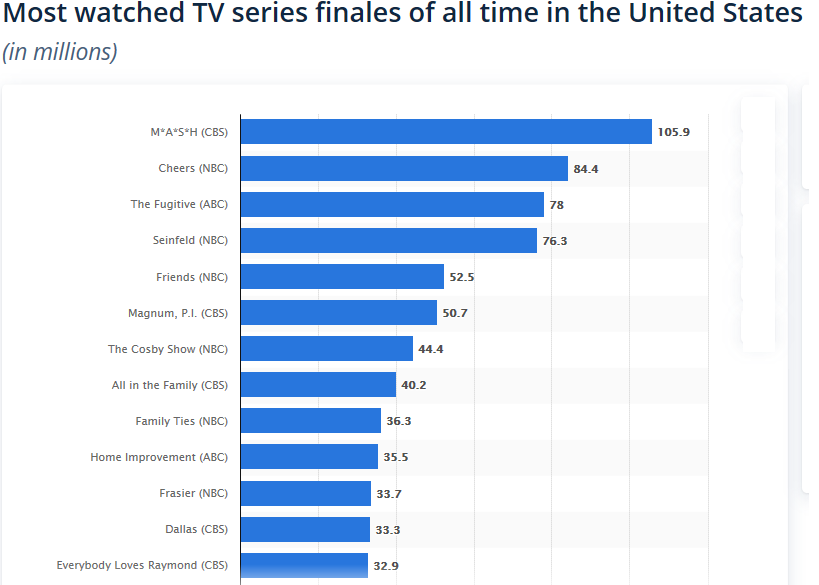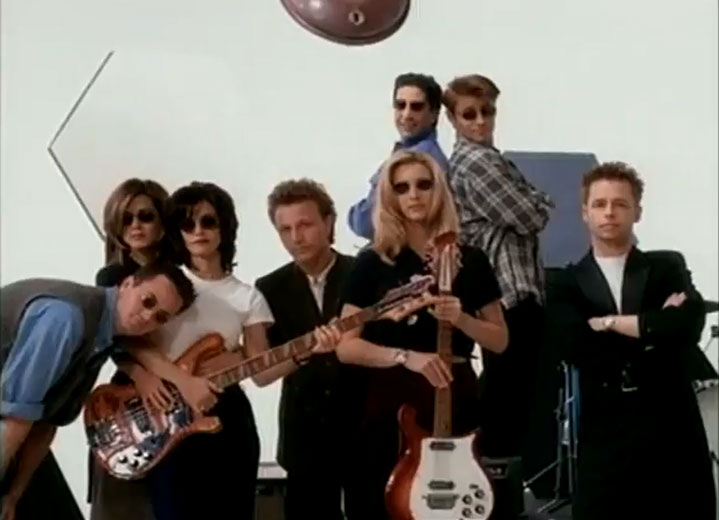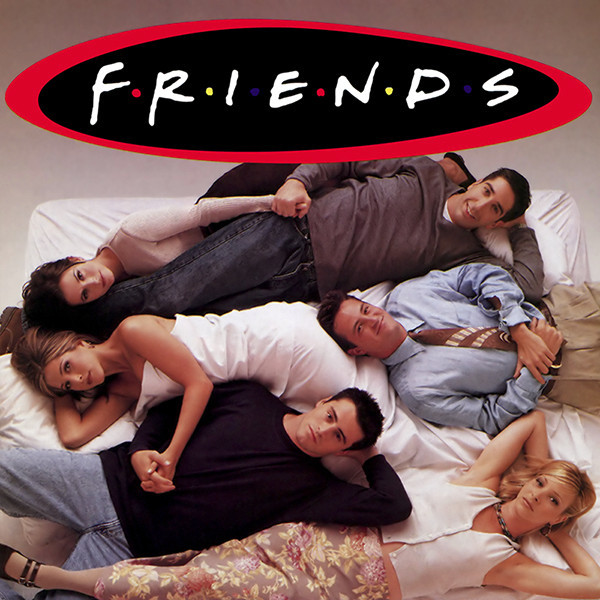If there is anything to forget about F.R.I.E.N.D.S…
In case you’ve been trapped and been forced to live in a cave covered by a very, very, very large immovable boulder, you will have seen or at least heard of the American sitcom simply known as Friends or F.R.I.E.N.D.S. (if you want to be pernickety about it). Over 10 seasons and 236 episodes, millions of people in the USA and beyond followed the lives of Rachel, Ross, Monica, Chandler, Phoebe and Joey. The show was a smash hit throughout its run, receiving 62 Primetime Emmy nominations and consistently ranked within the top ten of the US television ratings, topping the charts in season 8. The show’s final episode ‘The Last One’ raked in 52.7 million viewers in May 2004, making it the fifth most-watched season finale in US television history (fourth amongst comedies) and the most-watched television episode of the 2000s. Even fifteen years later, the show remains enduringly popular, being one of the most-streamed properties on Netflix.

Some people reading this post will wonder why I am writing about Friends on a website called Forgotten Media. I will explain right now (if you haven’t already read the title). To capitalise on the show’s success, a Friends soundtrack album was released including music featured on the show. In fact not only did they release one Friends soundtrack album, they released four soundtrack albums across the show’s run. Considering the show is celebrating its 25th anniversary, this reviewer will send many happy returns along with a review of the first soundtrack album: Friends, The Original TV Soundtrack. Is it any good? Let’s find out.
The Original TV Soundtrack was released by Reprise Records in October 1995 at the beginning of the show’s second season. It is obvious to see that the album was a reaction to the show’s stratospheric rise to the top of American television and mainstream popular culture. The evidence was clear to see in the viewership for the show’s first season. The show’s pilot episode attained 21.5 million viewers, finishing 15th in the week’s ratings. By the series finale (‘The One Where Rachel Finds Out’), the show had leaped to 2nd in the week’s ratings, broadcasting to audiences of 31.3 million people. Therefore in 1995, an album was compiled featuring the music of established acts Lou Reed, The Pretenders, Joni Mitchell and R.E.M. along with current stars Hootie and the Blowfish and k.d. lang.
And the result is… good, but not great. That’s not to say that any of the songs are bad (depending on whether you believe the lists that rank the full-length version of the show’s theme song as one of the worst songs of all time e.g. Blender). On he subject of said theme song, one of the most famous the most recognisable theme songs of all time, The Rembrandts ‘I’ll Be There For You bookends the albums as tracks 1 and 13. The edited TV version opens the album as if opening an episode with the full-length version closing the collection (featuring all the lyrics you didn’t remember after the first chorus had ended). We all know the short version and the long version is okay. The rest of the lyrics carry on exploring the hardships faced by a twenty-something having to grow up fast living in New York (You’re still in bed at ten and work began at eight/You’ve burnt your breakfast so far things are going great/Your mother warned you there’d be days like these/) while being reassured by your friends that they’ll be there for you through all these times. However, the lyrics do feel tacked on as if the original sub-one minute theme song had to be re-recorded as a three minute song to be applicable for radio airplay to supply popular demand, and it was. We all know the song became a hit, watching number 17 on Billboard’s Hot 100 and reaching the top 10 in eight further countries including the UK, Canada and Iceland. Anyway on with the rest of the album and here I was thinking that the album would be the theme song twice followed by all the musical stings the show used to transition between scenes over the years.

The album properly begins with Hootie and the Blowfish and the song ‘I Go Blind’, a cover of a song by the Canadian alternative rock band 54-40. When the album was released, Hootie were in their Grammy-winning best-selling prime and became a plot point in Season 2’s fifth episode ‘The One with Five Steaks and an Eggplant’ when tickets to a Hootie and the Blowfish concert split the group along financial lines with Joey, Phoebe and Rachel refusing to the concert seeing the tickets as an unwelcome act of charity by the other three. The song itself is a great listen and as a ‘Hootie’ fan (don’t judge me), this is the song that has been played the most from this album. You do have to get by some of Darius Rucker’s oversung lines but otherwise the song has a simple but effective melody, great lyrics and some good harmonies between the band members.
This is followed by ‘Good Intentions’ by Toad the Wet Sprocket. As a non-American, I did not know the first thing about this band before hearing this album. From my research, this song came during the band’s commercial peak. The three years prior to 1995 had delivered two now platinum-selling albums and four singles charting on the Billboard Hot 100 including two in the top 20. This song is a good follow-up to the previous track, with both songs featuring lyrics about ‘going blind’. Honestly the song is also very good and moves along at a nice pace featuring a good riff that threads the song together complete with a decent vocal performance by lead singer Glen Phillips. The song’s inclusion on the soundtrack proved to be a soundtrack, charted in the top 20 of Billboard’s Mainstream Rock and Adult Contemporary charts. In fact, this song and ‘I’ll Be There For You’ were the only ‘hit singles’ to come from this album.

One of the album’s best tracks comes from Lou Reed and the track ‘You’ll Know You Were Loved’. The song is not likely to be talked about among the rest of Reed’s more popular works but this reviewer would recommend it. Performed in his own inimitable and understated style, the song is a great tale about the lasting effect of love in a relationship and the pleasant memories that remain even after a relationship has fallen apart.
Other highlights to come from this collection include Grant Lee Buffalo’s ‘In My Room’. The song serves as a more downbeat, grungier rendition of the original 1963 version recorded by The Beach Boys. Slowing the song down brings more attention to more emotional lyrics contained in the song pertaining to what is done in the aforementioned room (Do my dreaming and my scheming/Lie awake and pray/Do my crying and my sighing/Laugh at yesterday). The album contains two enjoyable entries from notable bands: the then-established R.E.M. with ‘It’s A Free World Baby’ featuring Michael Stipe’s poetic yet confusing lyrics, and up-and-comers Barenaked Ladies with ‘Shoe Box’, a fast-paced but cheeky song where Steven Page sings about a secret relationship between a younger man and an older woman. Both songs along with The Pretenders’ cover of ‘Angel of the Morning’ will be enjoyed by fans of each band and fits along the lines of their usual styles.

The only song from the album I would not recommend is a remix of a popular song and a classic song to boot. Having done my research, I have found many remixed versions of Joni Mitchell’s signature 1970 folk song ‘Big Yellow Taxi’. I would recommend the original song to anybody, but I would not recommend the ‘Traffic Jam Remix’ to anybody. This version features the looping of the chorus’s final line throughout (Don’t know what you got/Don’t what you got etc.) along with some ill-fitting beats that were done to mimic a traffic jam I guess. Within these mild annoyance, you find the original song which sounds as if Joni has to struggle to make herself heard above all the hubbub. Give it a skip and listen to the original.

Despite containing a number of great tracks that do enough to transport you back to the mid-1990’s, it is fair to say that the album does not flow together well, if you catch my drift. Following the first three tracks of ‘Hootie’, ‘Toad’ and ‘Reed’, the album’s pace slows with k.d. lang’s ‘Sexuality’, a perfectly serviceable song worth listening to. However, it doesn’t quite fit when followed by the fast-paced ‘Shoe Box’ before the pace slows slightly again with R.E.M.. For anyone wondering why these 12 tracks were chosen to fit alongside one another on this album would be interested to know that all 12 have something in common. All the artists on this album were under contract to Warner Bros. Records or its subsidiaries Sire and Reprise. For a show produced by Warner Bros., production company wanted a list of songs that were ‘inspired’ by the show. All of these tracks would be featured directly in the show during its second season. However, the importance of any of these songs is not on the level of Chris Isaak’s Wicked Game (used for Rachel and Ross’s first kiss in this very series) or Eric Clapton’s ‘Wonderful Tonight’ (used later in the Season 6 finale for Monica and Chandler’s engagement). Seven of the songs feature in the same episode ‘The One with the Two Parties’ where Rachel has two birthday parties running in two apartments simultaneously in order to keep her divorced parents separated.
The other issue I have with this album is what takes place after most of the songs. Many of the songs are followed by clips of dialogue taken from the show’s first season. However, except for Joey’s announcement as Al Pacino’s butt double, the dialogue, along with feeling disembodied and out of place on an ‘inspired by’ soundtrack album, is mostly unmemorable. The dialogue seems to take you by surprise, appearing thirty seconds after the previous song had entered. After ‘Angel of the Morning’ has finished, the song’s backing suddenly reappears out of the blue to serve as a somewhat lead-in to the ‘related’ dialogue. The album would be improved if the dialogue was removed or replaced with some more notable lines.
To no one’s surprise, the album was a success. The album debuted at #41 on the Billboard Hot 200 Albums Chart and has sold more than one million copies worldwide. The album would be followed by three further soundtrack albums: 1999’s Friends Again, 2004’s 6-track Ultimate Party Soundtrack and 2005’s 2CD 34-track Ultimate Soundtrack, none of which charted. As mentioned earlier ‘I’ll Be There For You’ and ‘Good Intentions’ proved to be the hit singles from the album.
Looking at the album as a whole, the 13 tracks do seem to reflect the musical tastes of six twenty-somethings from 1995. To my modern ears, the album is good, but does have its issues. If you are a Friends superfan, I would recommend giving this listen or you could just buy the Ultimate Soundtrack. If not, I probably wouldn’t buy this.
The album even features a ‘hidden’ bonus track. It’s…an instrumental version of ‘I’ll Be There For You’, a song you’ve already heard twice on the original album. Happy 25th anniversary, everybody!

